Use the following link to download the May 18, 2024 issue of the syəcəb
Category: Tulalip News
It’s For the Kids! Annual auction raises nearly $600,000 for Tulalip Boys & Girls Club

By Micheal Rios, Tulalip News
A short-lived heat wave hit Snohomish County last weekend. Temperatures touched 80° on Saturday, May 11, resulting in many people either staying inside to avoid the sun rays or actively searching for a fun Spring-time experience. Some six-hundred Snohomish County residents weren’t burdened by such trivial things because fortunately they had already RSVP’d to the always exciting and memorable, not to mentioned well air-conditioned, 26th Annual Boys & Girls Club Auction.
Hosted within the Tulalip Resort Casino’s Orca Ballroom, the signature fundraising event of the season was all about giving gracious donors and committed community members an opportunity to paint a brighter future for Tulalip’s children.
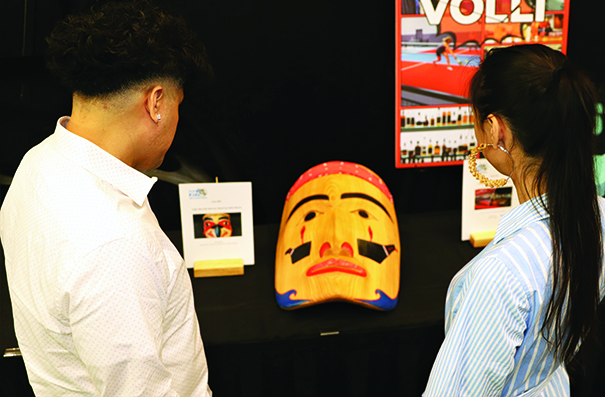
“Many of us have spent unlimited hours at our local Boys & Girls Club participating in sports and learning activities while others remember our local club as a safe place to be surrounded by friends and staff members we trusted,” stated auction chairwoman Marci Fryberg. Marci also serves her Tribe as President of Tulalip Gaming Operation. “Our personal experiences have led to a life-long commitment to an organization that had a positive influence in our lives growing up, and now it is our responsibility to carry that commitment forward.
“Our theme, Woven through Generations, highlights Tulalip’s commitment to family and how our communities work collectively to safeguard the future of the next seven generations. We are honored to celebrate 26 years of fulfilling our mission of promoting health, social, and educational development of our kids. Our club cares for hundreds of kids daily. Magic happens here, as our kids strive to achieve higher levels of learning and personal growth while creating special friendships and bonds that last a lifetime.”
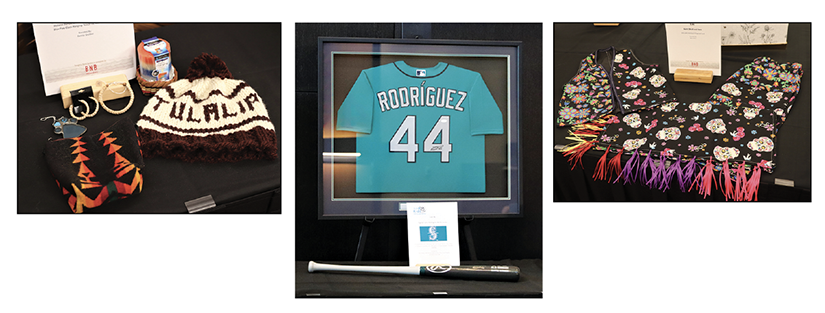
‘The Club’, as it’s affectionately been dubbed by two generations worth of Tulalip youth who attend daily, is a safe place where kids can just be kids. While there, they are routinely exposed to nutrient-dense, healthy food choices, learn useful skills that can be put to work at home or in the classroom, and create an abundance of happy memories that can be remembered later in life.
An example of sovereignty in action, the Club is the first-of-its-kind to be built on tribal land in Washington State. Established over twenty-five years ago, 2024 marks nearly three decades worth of commitment to the community. Through before and after school programs, our reservation’s club aims to help the next generation improve their lives by building a positive self-esteem, developing core values, and adapting critical skills during their foundational periods of growth.
“What an amazing evening to be together with all of you for our signature event that supports the Tulalip Boys and Girls Club,” said Tulalip Chairwoman Teri Gobin to the hundreds in attendance. “The funds raised from this one event truly makes a huge impact on the lives of so many of our kids. We have so many leaders who grew up as club kids and now are professionals working in management positions at both our casinos, Quil Ceda Village, and in many departments of our tribal government. That’s a significant impact the Boys & Girls Club has had on our people.”

Serving as a model for those working to improve the lives of young people in Tulalip and the surrounding communities, our Club is the primary beneficiary of the annual spring time auction. With each auction building off the success of the previous years, the Club has not only been able to sustain services, but also develop and complete much needed campus expansions that add additional learning and activity space.
Funds raised from the annual actions are dedicated for capital improvement, not operating costs. Previous auction funds have paid for a state-of-the-art music studio, a multi-media room with twenty-plus computers, several transportation vehicles, roof repairs, and even a 4,000-square-foot technology-filled extension to better accommodate an ever-growing teenager membership. This teen center has been invaluable since its creation. In uncertain times, local teenagers are able to depend on access to this tech-loaded space to meet their computer-driven demands as 21st century students.
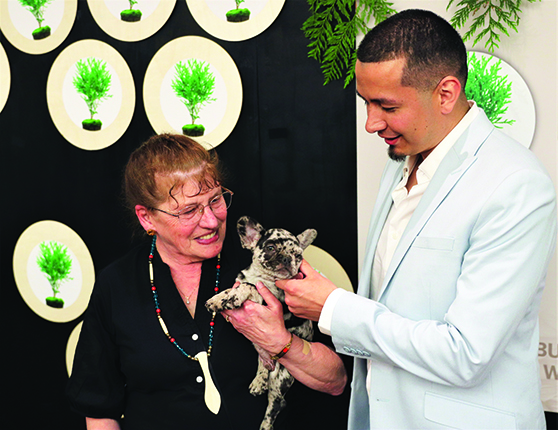
“It’s so funny looking back because I didn’t realize how much the Club meant to me as a kid, but really it was everything,” shared Club Director, Shawn Sanchey. The 28-year-old homegrown Tulalip citizen has come full circle after he himself grew up a Club kid. Now, he manages the same facility so many kids depend on every day. “It’s amazing being able to witness these kids learn and grow in the same way staff once did for me. It really is unique how dedicated our staff are to the community’s youth.”
Embodying his staff’s unique dedication to the community is the legendary Diane Prouty. She’s been safeguarding Tulalip’s club kids for 24 and a half years. She learns every single kid’s name who is a club regular and takes to heart their emotional and physical well-being as if they were her own grandkids. It’s no wonder then that she’s been lovingly referred to as Grandma Diane by thousands of kids at this point. A title she proudly owns.
“All nine of my actual grandkids attended the club, and when they were here they’d of course call me grandma so eventually the other kids did, too. I thought it was just the cutest thing. I had no idea twenty-four years later that would become my de facto name, but I love it because it’s the kids who gave it to me,” explained Diane as she assisted checking in auction guests. “Every year, at this auction, I see former club kids all grown up, who have started families of their own and have kids who attend the club today. Ross and Krisan Fryberg were both club kids. Now, they are married and have had multiple kids attend the club, just like they once did.”
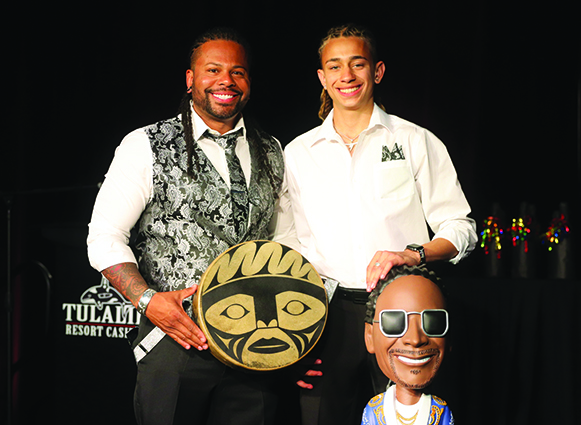
Ross Fryberg Sr. donated a beautiful, handcrafted drum to the live auction. It was brought to center stage by his son, Ross Jr., where it fetched a handsome sum to support a facility both Sr. and Jr. have cultivated many memories.
In total, there were an estimated 600 generous individuals in attendance for this year’s 26th annual auction. Most of these attendees have never been inside Tulalip’s reservation-based B&GC Club. However, the uplifting faces of Club kids were ever-present on marketing materials and projected onto several giant screens bordering the Orca Ballroom. There were also a number of teenagers who volunteered during the auction to help generate support by sharing their wonderful presence and beaming smiles.
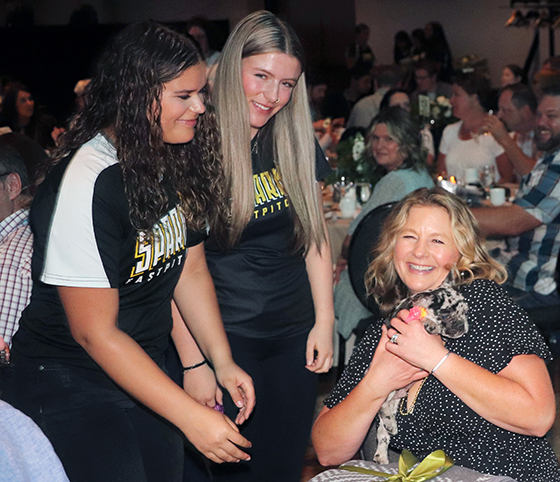
One such teenager was 16-year-old Amaya Hernandez who, during the live auction, was one of the lucky few to roam the ballroom while holding a very special item – a French Bulldog puppy – that generated all kinds of buzz. When auctioneer Mark Schenfeld announced it was bidding time for the adorable pup, amass of bidding cards immediately filled the air. The eventual winner received the French Bulldog hand delivered by Amaya and her Snohomish Spark teammate, Ella Roller.
When the 26th annual action finally came to an end, close to $600,000 was raised between the silent and live auction proceedings. Notably, a generous $25,000 of that impressive sum was raised by U.S. Bank’s Smokey Point branch. The bank staff embraced the celebratory atmosphere and combined their powers to claim top spot in the event concluding dessert dash.

“At the end of the day, this auction is really about building relationships with the community and continuing to build upon the strong foundation of support we have with the Tulalip Tribes, Snohomish County, and the Tulalip Resort Casino,” said Terry Freeman, special event specialist for the Boys & Girls Clubs of Snohomish County. “For twenty plus years now, our goal has remained the same – to create more and more partnerships off the reservation to achieve our goals on reservation. Thanks to our Tulalip leadership team and the leadership teams of so many amazing businesses in Snohomish County, we continue to meet and exceed this goal.”
Thanks to everyone who contributed and gave generously, the 26th annual action was a major success. The generosity and heartfelt support received each year from sponsors and volunteers is overwhelming. As in years past, all funds raised will ensure our local Boys & Girls Club continues to provide quality, growth-focused programs in a fun, safe and positive environment for kids.
Can You Dig It? Tulalip Natural Resources helps community grow together with a garden workshop
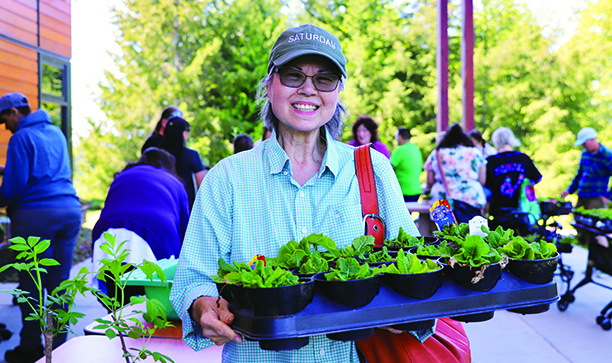
By Kalvin Valdillez, Tulalip News
In the heart of the spring season, the Tulalip Tribes Natural Resources department put together a successful event dedicated to a popular springtime hobby, though many would argue that gardening is a way of life, in both the literal and figurative sense.
Natural Resources opened the garden workshop to include all residents of Tulalip. On the morning of May 11, close to 60 community members showed up at the Tulalip Admin Building to really dig into the art of gardening and learn about the many benefits that plants have to offer, while cultivating new skills and knowledge along the way.
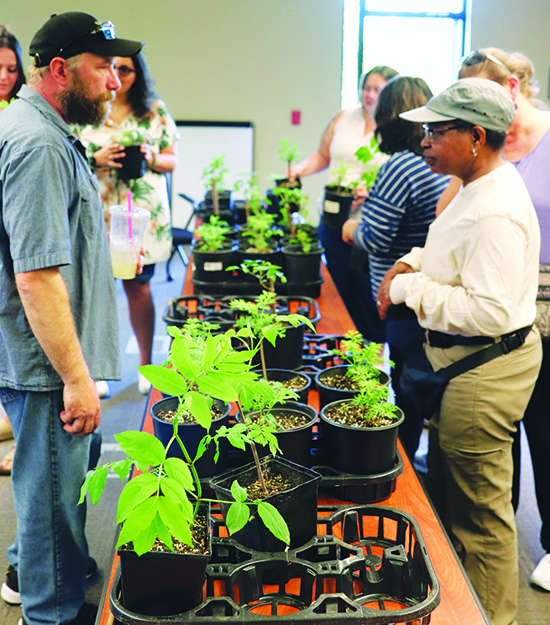
“I have always loved gardening and working in the yard. To me, it’s relaxing. Even pulling weeds, I just really enjoy it,” shared community member and home gardener, Catherine Key. “I decided to come when I saw the flyer and all the subjects looked interesting. I just think it’s really cool that the Tribe did this.”
The garden workshop featured three presentations that focused on several aspects of gardening. Valerie Streeter, Tulalip Natural Resources Stormwater planner, opened the three-hour event with a presentation titled, Go with the Flow, that informed the people about watersheds, rainwater collection, and natural yard care. Local Horticultural Inspirer, Seth Smith, led an informational presentation dedicated to growing a garden for sustenance, which included a Q&A where people absorbed any and all insight that Seth had to share.
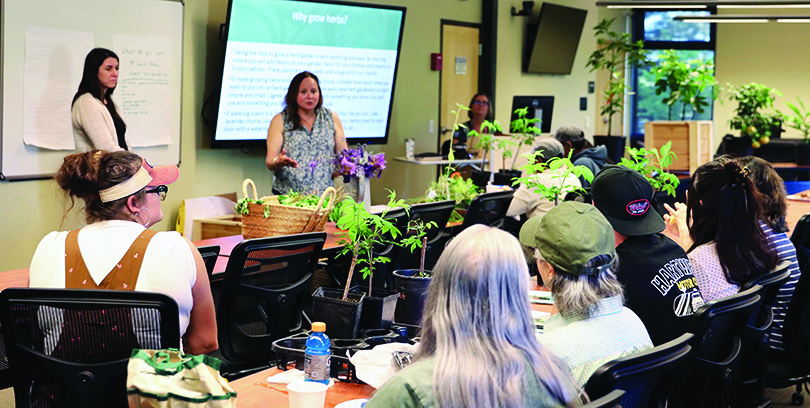
Said Seth, “Today I talked about subtropical plants, citruses, fig trees, pomegranates, any unique plant that’s not apple trees or pear trees that we’re all familiar with. I wanted people to think outside the box, open their mind and inspiration to achieve things that people would rather you not succeed at. [Gardening] allows you to free your mind of negativity on the day to day. It allows you to have your own space, and I think that’ll allow you to clear your mind of work, family drama, vehicle issues, and allow you to just focus on yourself.”
The Tulalip Health Clinic Diabetes Program presented a detailed lesson on the medicinal usages of plants, while also touching on the native plants of this region, essential gardening tools, and the special connection to the natural world that we experience as Indigenous people
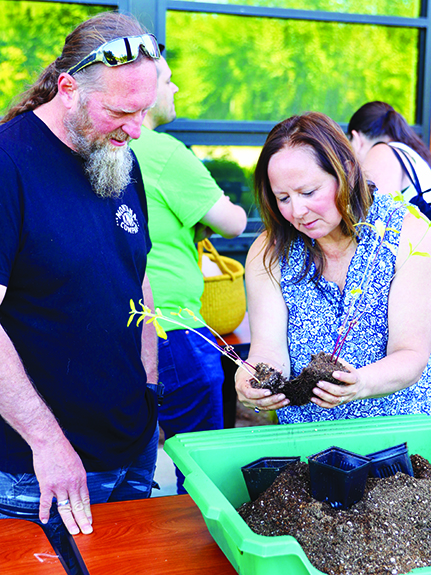
Tulalip Diabetes Educator, Veronica ‘Roni’ Leahy explained, “Plants were here before people, we think of them as our first teachers. The more you’re around them, the more you feel connected. Think of them as friends that you get to see once a year. Enjoy your time with them, go and be out with nature. I brought two plants that are representing us today; Camus is a native plant and you’re on tribal lands. Sacred plant, sacred land. And iris, which we planted at the Tulalip Health Clinic, it represents the community, this group of people who were able to come out and learn today.”
Along with Roni was Herbalist, Leslie Lekos, who explained the step-by-step process of creating tinctures from plant extracts, that could be used as home remedies to help treat a variety of ailments such as nausea and muscle soreness. Leslie has numerous tinctures and sprays for sale in her Etsy store, Wild Root Botanicals. She also teaches hands-on classes throughout the year including Foundations of Herbalism and Wild Foods: Resiliency Through Connection, more details can be found on her website. Following the presentation, both Roni and Leslie held live demonstrations on transplanting and creating tinctures.

The event ended with a raffle drawing and a plant giveaway, in which people received primroses, elderberries, planter boxes, and compost.
“The turnout was great. It did turn out really cool today,” exclaimed Melissa Gobin, Tulalip Natural Resources Environmental and Education Coordinator. “At the Earth Day planning meetings, that started in January, a lot of people were talking about sustainability for food and growing our own foods, along with rain gardens. Val (Streeter) has a grant through the EPA, and she has money to put on workshops to talk about rain gardens. I met with Seth and he’s a garden guru, and also with Roni because she’s amazing with gardens and we’ve been learning so much from her, and Leslie too. So, we just wanted to get all these people together to inform the community and give them some inspiration to get out and garden.”
She continued, “On May 22, we’re going to be at Quil Ceda Elementary and we’re going to have Farmer Frog there to help us put plants in the ground. It’s going to be a Plant 101 course on how to put them in, the dos and don’ts, and we’ll be going over a lot of the basics because it’s Family Day at the elementary. And hopefully in the future we’ll have more of these classes. I also want to start a gardening group, something where people can get together to plant, seed exchange. Earth Day is every day and we’re going to have a bunch of stuff going on now. I’m just so glad there were so many people that came out and enjoyed it and seemed so engaged.”
Equipped with invaluable gardening game, new plants, and tools, the people were eager to get back home to enjoy the sunny weather and get lost in their personal gardens.
Following the garden workshop, community member, Tracy Owens, shared, “I got the flyer in the mail and I’m really into gardening. I wanted to see if I was going to learn something new and share different ideas. Ever since we bought our property here on Tulalip, we’ve expanded something new every year to our garden. We have herbs, we have vegetables, we have flowers. I just love it. Today I enjoyed learning about different plants and just listening to people talk about gardening and seeing their love that they have for plants too. You can see that plants make people happy.”
Community sobriety celebration
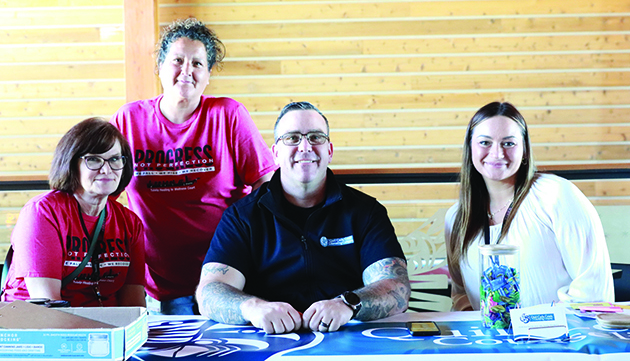
By Wade Sheldon, Tulalip News
On Friday, May 10, staff from the Tulalip Healing to Wellness Court, Quil Ceda Creek Counseling, and the Recovery Resource Center convened at the Tulalip Admin Building. The purpose of this gathering was to honor the achievements of the individuals referred to the Wellness Court. Erica Moore, Wellness Court Treatment Coordinator, took the lead in organizing the event.
She collected statements from the program’s graduates and current participants, which she then used to create a slideshow. This visual representation showcased the remarkable progress of the individuals, including milestones such as maintaining sobriety for a certain period, securing stable employment, and rebuilding relationships. Following the presentation, the audience was invited to reflect on the content and share words of support and encouragement for the individuals featured in the slideshow.
For those who don’t know, the Wellness Court was designed after the Drug Court, which was created in 1989 to reduce crime and give those who aren’t violent offenders a chance at not being incarcerated or getting a felony conviction. Tulalip’s Healing Wellness Court goes further than customary drug courts by implementing cultural traditions, community, and reconnecting families. These cultural traditions can include attending ceremonies, which play a significant role in the recovery process.
“I have been involved with Wellness Court for over a year,” said Christine Frauso, Wellness Court Judge. “The program is amazing; I have watched people grow exponentially. These programs help reconnect people with their culture and community, a huge part of their recovery. I came from the state system where they didn’t have that cultural component, which isn’t nearly as effective there.”
The Wellness Court program participants receive personalized support and guidance to address their needs, whether finding employment, accessing mental health services, or rebuilding relationships. The program’s holistic approach focuses on the individual’s personal growth and reintegration into the community and family, setting them up for long-term success beyond their time in the court system.
“I got involved with this program in 2017 during the first years it was open and graduated in 2018,” said Erica. “I decided to get a job with the Wellness Court because I graduated from the program, and I believe in this program. It changed my life. When I started the program, I thought I didn’t want or need it because I was an adult and could do it independently. I quickly discovered that having these people on your side wanting me to succeed and showing me that I could love myself helped me understand that anything is possible when you have people who care.”
It’s a significant accomplishment to find an even keel in life. Sometimes, when you’re down on yourself because of the wrong choices you have been making, thinking you deserve better can be hard to see. For tribal member Gerald Williams, staying on the straight and narrow was difficult before becoming involved with the Wellness Court.
“Once I got into the program, I found out that all the staff was supportive.,” explained Gerald. “They taught me how to live life clean and sober, and the requirements to take care of yourself, like going to the dentist or the doctor. The program saved my life. If I had gone into any other court system, I would’ve kept running from jail like I usually did. So, I am grateful for Wellness Court.”
Tulalip Healing to Wellness Court illustrates the power of community and tradition in overcoming addiction. As participant Gerald aptly described, “You need to put as much work into sobriety as you did into getting drugs and alcohol.” The court helps individuals like Gerald rebuild their lives through support and guidance, offering hope for a brighter future.
For further information regarding Tulalip Healing to Wellness Court, please feel free to call (360) 716-4764 at 6332 31st Ave NE, Suite B, Tulalip, WA 98271.
Reflections from Gathering of Nations
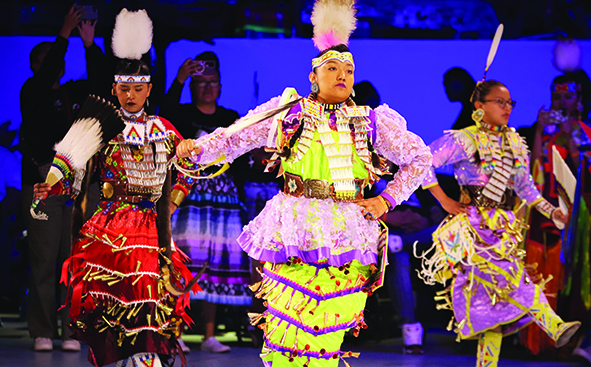
By Micheal Rios, Tulalip News
The Gathering of Nations, known as the largest powwow in the United States, is more than a cultural celebration – it’s a thriving hub of triumph that showcases tradition and a fierce determination to honor our ancestors.
Of course, there is a constant emission of celebratory vibes as thousands of culture bearers from across Native America come together to witness the highest echelon of powwow performances. From tiny tot to golden age, Native men and women from all across the four directions take to the arena floor to proudly dance like their forebearers. From fancy shawl to jingle dress and traditional, to fancy dance, grass dance and the always captivating chicken dance, 2,200+ dancers radiated generations worth of resistance to colonial assimilation over the three-day Gathering.
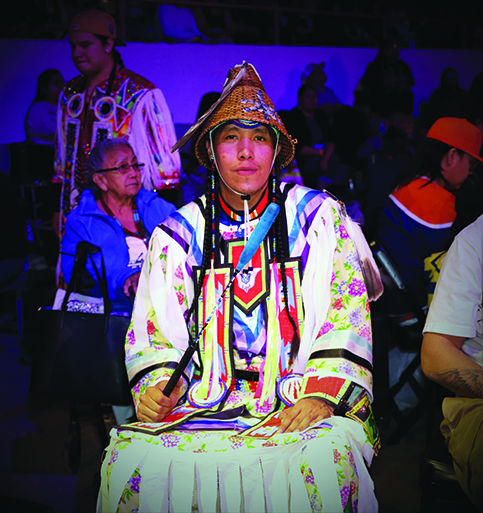
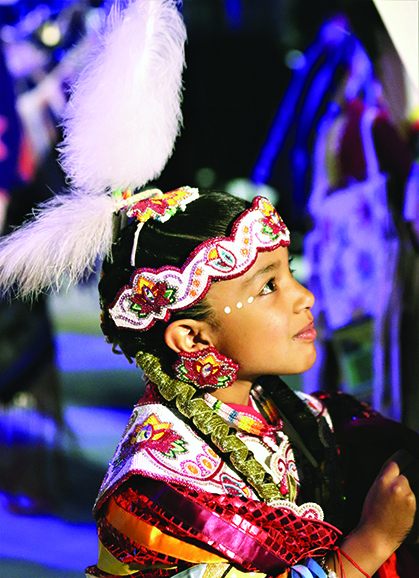
There are entire families who view Gathering as an annual rite of passage that demonstrates their commitment to each other and to those who came before them. Like the Yarholar clan from Sac & Fox Nation. Father Cortney learned to fancy feather dance from his grandfather and has since taught his 14-year-old son and 9-year-old daughter how to carry on the fancy feather legacy.
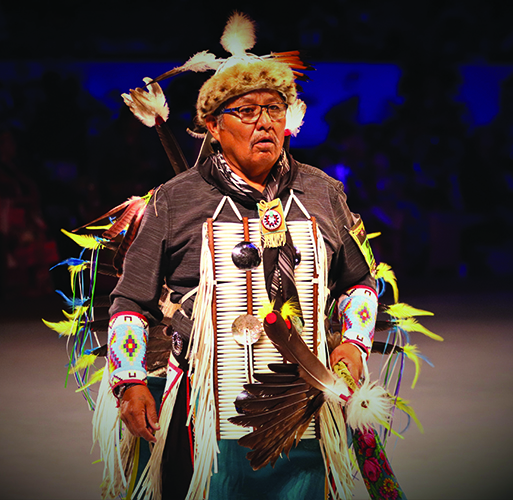
“The fancy feather dance has been a part of our family tradition for generations. How it’s been explained to me was we had a grandfather, way back there in the family tree, who went through ceremony and was given a dance. He was told to take care of it and teach his children who would teach their children, so on and so forth,” recalled Cortney Yarholar. “With each passing generation, the older ones taught the younger ones not just the dance, but the lessons that come with it; how to hold yourself in and out of the arena, how to take care of the body and spirt, and how to embrace the good medicine that comes from it.
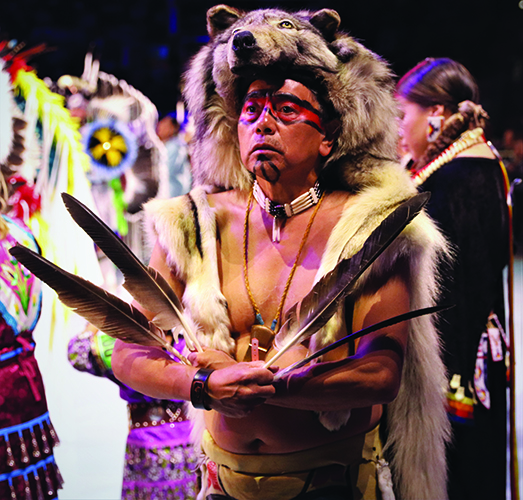
“It’s a gift from Creator that was given to my family a long time ago and continues to be a source of strength and unity, especially for the relationship between my son and I. It’s so special to be able to travel and share these experiences with him. Even the simplest of things, like helping him put on his regalia and braiding his hair, these are special moments we get to share. Each time, I’m reminded of when I was his age and my uncles helped me paint up. There are times when I watch my son and I remember being a little one dancing and looking over to see how proud my grandfather was as he watched me. He was 90-something at the time and couldn’t dance any more, but he’d sit there and tap his cane to match my rhythm. The harder I danced, the harder he tapped that cane while having this huge smile. So, for me, dancing fancy feather is a spiritual connection that links the past to the present.”
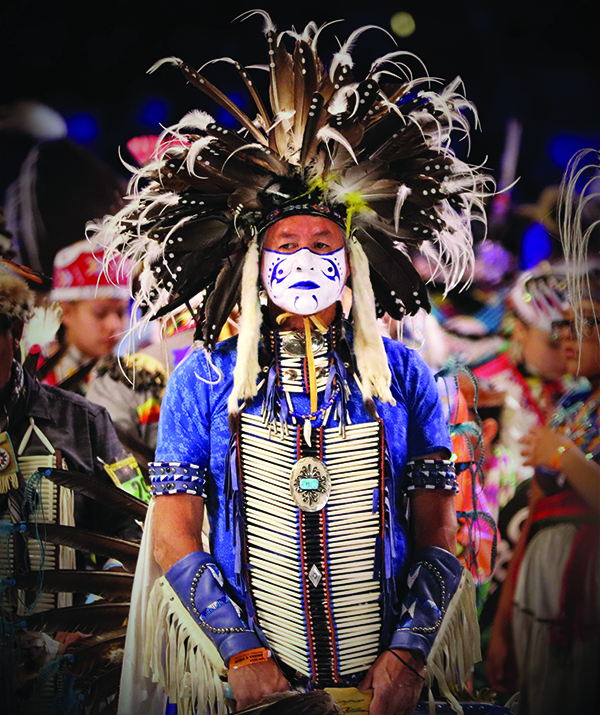
In the present, the youngest generation continues to lead in their own way. Often in such subtle ways that their offerings may be overlooked by those not paying great attention. Tiny in stature but immense in power are those little ones who carry on culture and tradition without even knowing it.
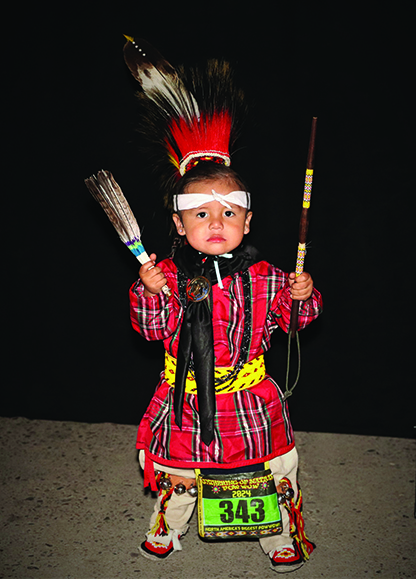
Such is the case with a remarkable 2-year-old named Roderick Walker (Seminole). He’s been immersed in the powwow circuit since the womb, with both his parents being acclaimed dancers. So much so that he’s created his own type of powwow dance. A resounding remix that represents his Seminole, Navajo, and Sac & Fox heritage
“Basically, he learned from all his family. His cousins, aunts and uncles, and grandparents are all dancers,” shared Roderick’s mom, Darrica. “He’s taken a little bit from everyone and created an all-around style all his own. It’s a little bit fancy, little bit southern, little bit traditional, and then a little bit whatever comes to him in the moment.
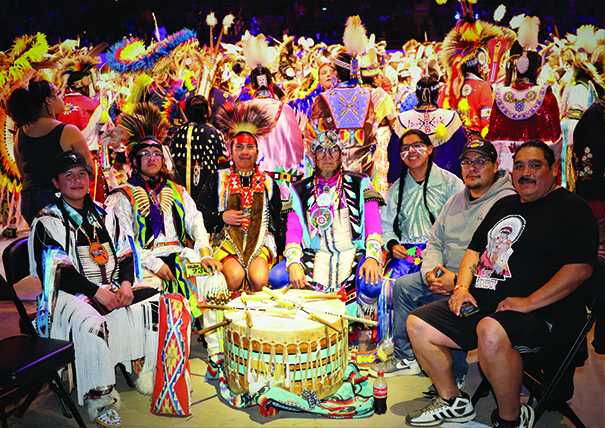
“We’ve travelled all around Indian Country and into Canada, too, for powwows and ceremonies,” she added. “We’ve never had to tell him to dance. As soon as he was standing and heard the music or heard the drum, he was dancing. He just loves it. I’m so excited to see him continue to grow and represent for his people wherever he dances.”
Young Roderick’s one-of-a-kind dance style earned him the title of #1 tiny tot boy upon the conclusion of Gathering of Nations.
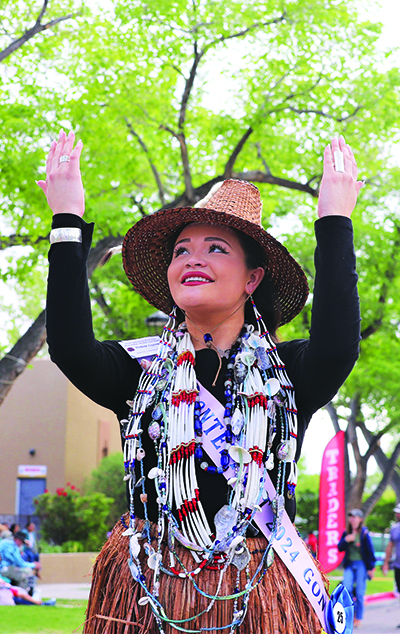
Among the tens of thousands of Native Americans who journeyed to Gathering, one particular powwow princess stood out. That was Quinault’s Violette Capoeman. Dawning a cedar cap and cedar skirt, while wearing an assortment of shell necklaces harvested from the Salish Sea, she was regarded as the only Coast Salish contestant vying for the coveted crown of Miss Indian World.
In traditional Pueblo territory, deep in dessert terrain and amongst so many tribal citizens from the Great Plains, the 18-year-old Violette was far from the familiarity of towering evergreen trees and endless blue sea.
“This entire experience has been a culture shock,” she admitted. “But we’re all relatives and interconnected by a larger sense of culture that allows us to befriend one another and share our personal stories and ceremony experiences. Over the past few days, I’ve really enjoyed being able to learn from my fellow princesses about their tribes’ customs. They’ve shared so much with me and I’m been fortunate to be able to share with them, too. There’s been so questions about my cedar regalia because they aren’t use to seeing it like we are back home.
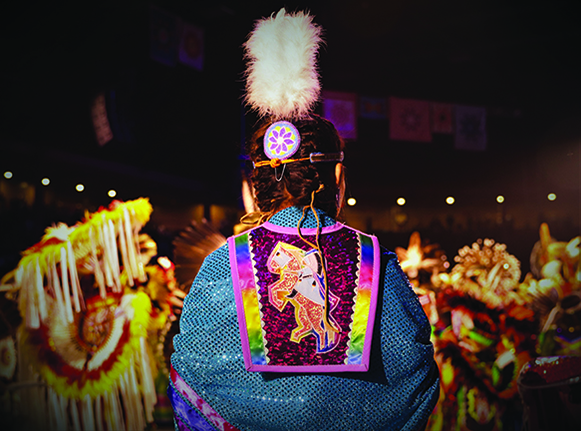
“Looking back at my time here in New Mexico, I’ve built so many friendships in such a short amount of time with people from all over the country. That’s really the beautiful thing at the heart of our Native American culture, that ability to connect.”
Violette’s traditional Lushootseed name translates to Where Thunder Dropped Whale. Befitting, since her growth and development on the powwow circuit gave her confidence, the internal thunder, if you will, to be dropped into Gathering of Nations and stand proud as the only Coast Salish princess; a symbolic whale in pueblo territory.
“It’s been a transformative experience, and I’m just so happy to be the representative for costal nations,” added Violette.
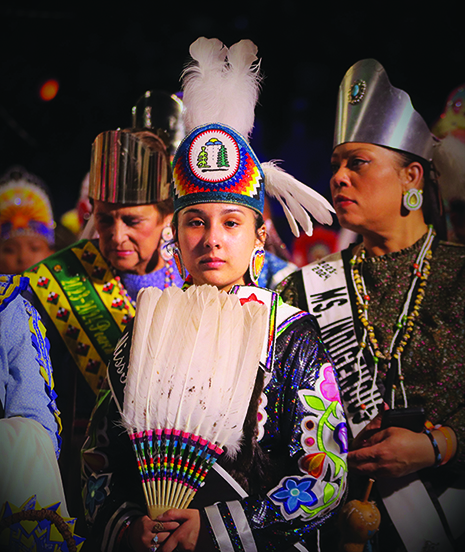
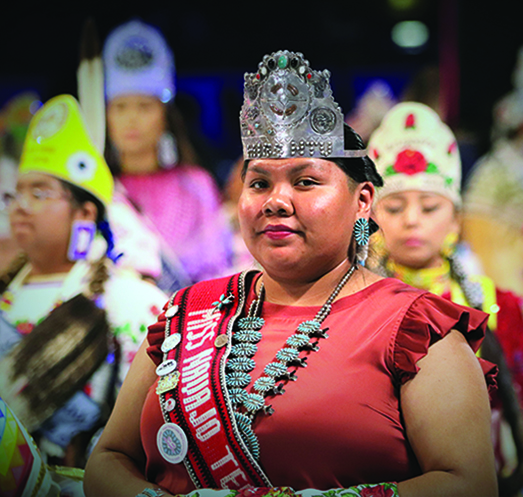
The sentiments expressed by Cortney, Darrica, and Violette give credence to the crucial role Gathering of Nations plays in sharing the many nuances of Native American powwow dance, music, regalia, and other contemporary cultural expressions, like those offered by 2-year-old Roderick. It’s both a hub of triumph and a platform of preservation for traditional practices that are very much alive, continuing to evolve, and remain as vibrant as the photographs accompanying this article.
May 11, 2024 syəcəb
Use the following link to download the May 11, 2024 issue of the syəcəb
Bringing the competition at the Annual Canoe Races

By Wade Sheldon, Tulalip News
Over the May 4th weekend, the chilly and wet weather couldn’t dampen the spirits of diverse and determined canoe pullers. Hailing from various tribes across Canada, Washington, and Oregon, they gathered at Tulalip Bay to compete in Tulalip’s 2024 Annual Canoe Races. With more than 70 talented contestants from different tribes putting their skills to the test, the air was thick with anticipation, enthusiasm, and tension. Competitors were determined to leave it all on the water and earn a chance to claim the coveted trophy and cash prizes that awaited the champions.
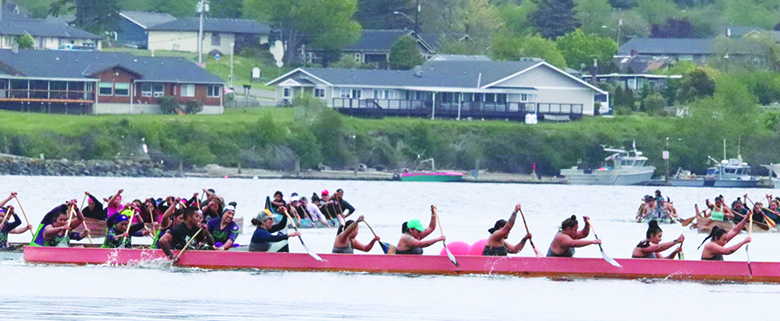
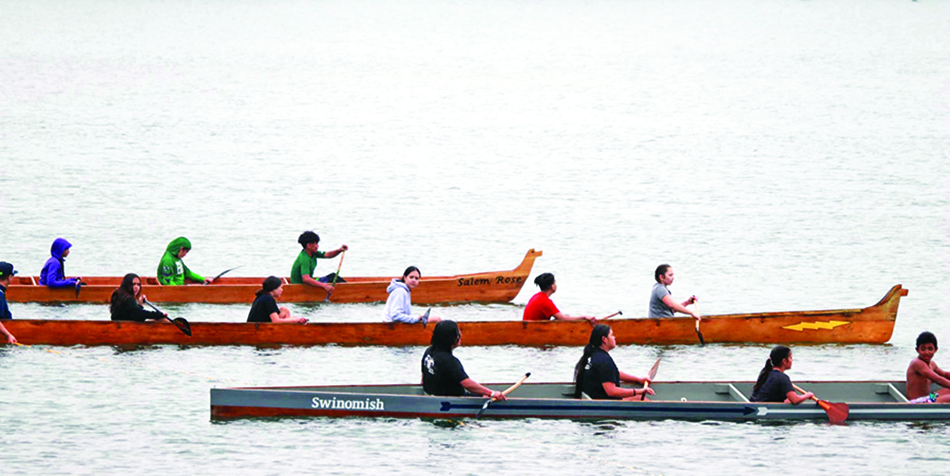
The races were a testament to strength and teamwork. The excitement was palpable as contestants paddled out and lined up between the buoy and the line judge, eagerly awaiting the sound of the horn. The atmosphere was charged with the sea’s smell and the waves crashing against the shore. It was a breathtaking sight as the massive wooden vessels would take a few pulls to gain momentum. Still, once everyone was in sync, they would gracefully glide through the water towards precisely placed buoys throughout the bay until crossing the finish line, with the cheers of the spectators echoing in their ears.
“I have been in canoe races for 30 years,” Nooksack’s Russell Roberts said. “I love seeing everyone coming out and working together. Also, getting all the youth out here to participate is a blessing. That’s why me and my brother’s canoes are made up of kids. It means a lot to have these races. My grandfather is the one who got the family started. He’s been gone for quite a few years now, and we hope we can continue his legacy for my kids and, hopefully, my grandkids.
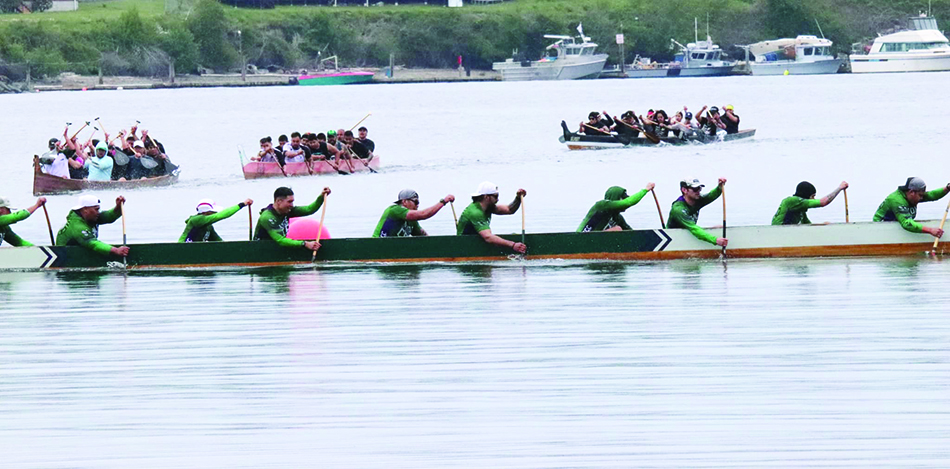
This year’s Tulalip canoe races saw more youth participants than adults, indicating a growth in the sport’s ability to bridge traditional practices with changing times. With four different age groups to participate in, kids of all ages were able to embrace the elements and try their might on the bay.
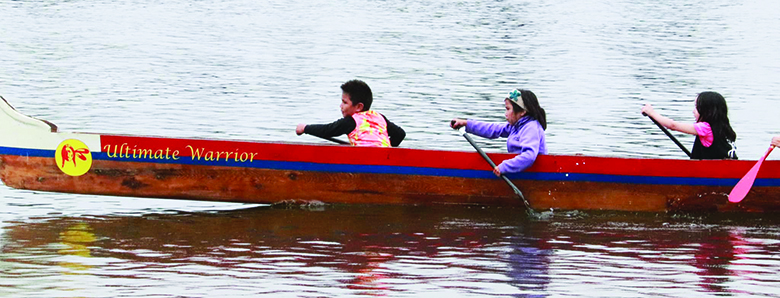
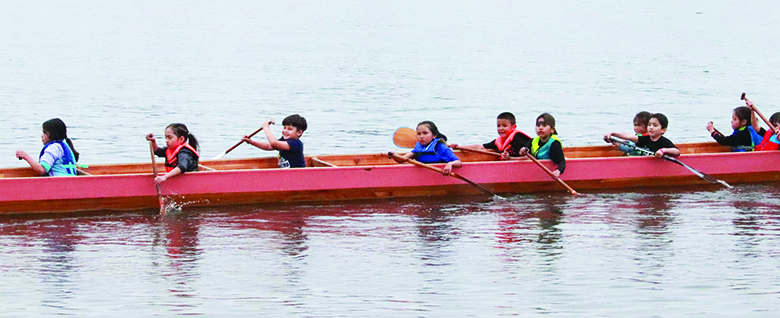
11-year-old Kora from Nooksack said, “I have been participating for five years. You have to make sacrifices to be able to participate in the races. It takes a lot of time and dedication to get good, keep up, and even win. My favorite part of this weekend was being on the water with my cousins. I say for all the new people who want to try it out, have fun, and be ready for anything.”
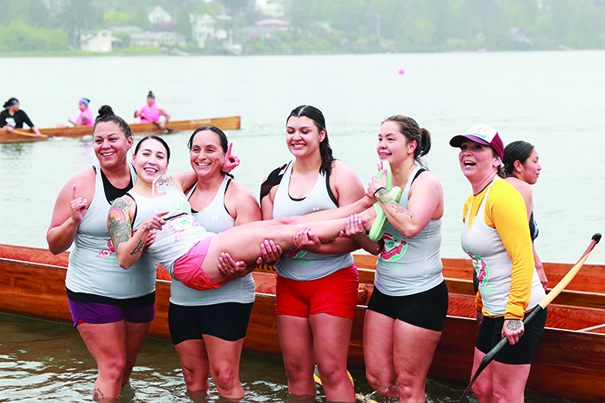
The water offered many challenges, each presenting an opportunity for personal growth. Lavarian Webster, a 19-year-old from Cultus Lake, Chilliwack, BC, seized these opportunities, participating in over ten races. His journey is a testament to the transformative power of these races, as he harnessed his skills and pushed his limits.
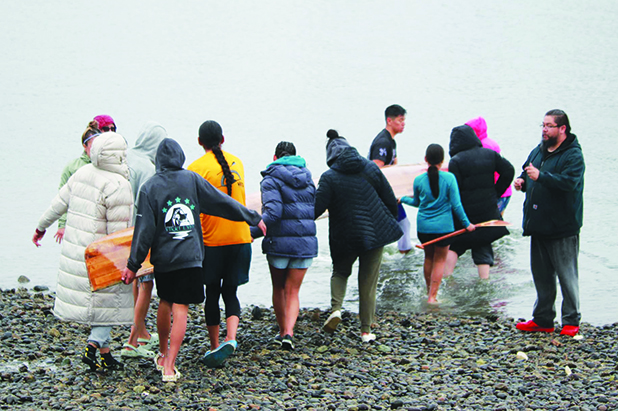
“My favorite part about this weekend has been getting back out to the races and hanging out with everybody,” Webster said. “This is my third season of racing, and I feel like I got off to a good start. Keeping the canoes alive and on the water is important to the native people. Having an event like this gives people from different villages a chance to get involved with one another. It was a great weekend, and I’m glad I got to be a part of it.”
Despite the cloudy and sunless weather, the competitors persevered and showed their tenacity in canoe racing. The determination and passion demonstrated by the competitors were truly inspiring. It reminded us that even when faced with adverse conditions, we can still achieve greatness if we keep pushing forward. As Russell Roberts said, “It’s just what we do!”

As the final echoes of paddles cutting through water fade into the distance, the 2024 Annual Canoe Races at Tulalip Bay leave behind more than just the thrill of competition. They serve as a reminder of the resilience, unity, and cultural pride shared among Indigenous communities across the region. Beyond the trophy and prizes, the true victory lies in the bonds forged, the traditions upheld, and the memories created on the waters of Tulalip Bay.
Say Their Names: Tulalip observes National MMIWP Awareness Day
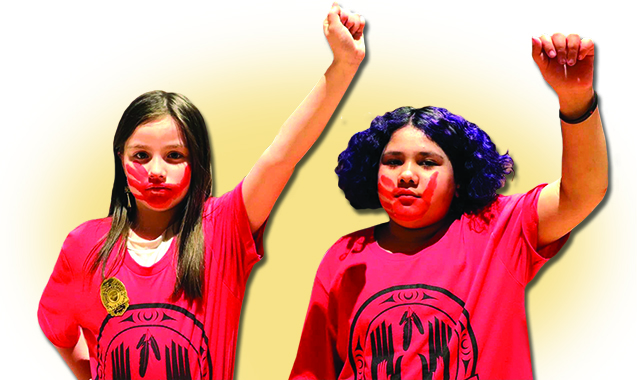
By Kalvin Valdillez, Tulalip News
On the evening of May 3, hundreds of Tulalip citizens and members from nearby tribes convened at the Gathering Hall for the 2nd Annual MMIWP Awareness Day event. Designed to bring attention to the MMIWP epidemic, as well as uplift those families who have been affected by the crisis, the MMIWP gathering at Tulalip is a rollercoaster of emotions that is equal parts heartbreaking and healing.
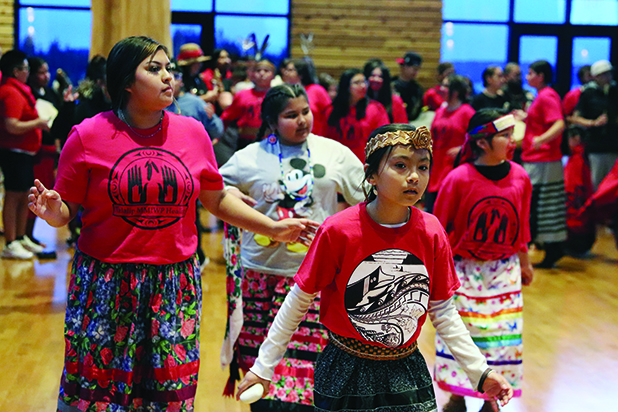
“The number of MMIP grows so much every year at Tulalip and across the land. The duty of spreading awareness on this matter falls on every one of us,” said Anita Matta, Tulalip Police Department Program Manager, and lead organizer of the MMIWP gathering. “I would like to share a few statistics: in Washington State, Native people make up 1.6% of the population, but make up 17% of missing people in the State. And as for violence against Indigenous women and girls, 4 out 5 of our women have experienced violence and 55.5% have been physically abused by their intimate partners. And 40% of sex trafficking victims are Native American and Alaskan Indian women.”
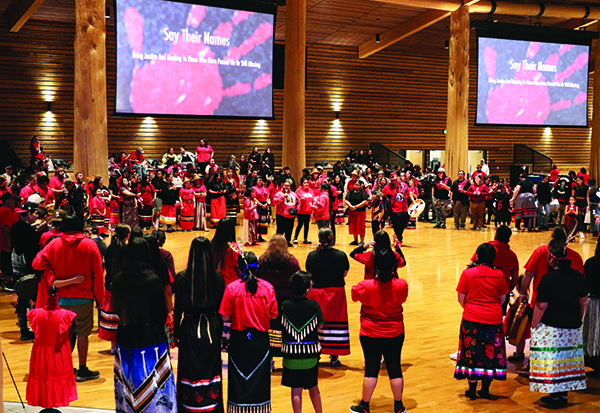
Nationally, May 5 is dedicated to raising awareness about the Missing and Murdered Indigenous Women and Persons epidemic that continues to plague Native America. Every day, more and more of our relatives are reported missing, and thousands of individuals have yet to be found. Additionally, the rate at which Native people are murdered in the US is higher than any other ethnicity. And it’s important to remember, that with any statistics gathered while dealing with the MMIWP epidemic, the true numbers may never be known as many cases and incidents are either underreported, misreported, or left unresolved.
Though still in its infancy stage, the MMIWP Awareness Day event has been met with great reception from the community, and has done an amazing job of paying tribute to those Tulalip members who have been reported missing or who have been murdered and are no longer with us. A recurring theme and important piece to this event is based around the phrase ‘SAY THEIR NAMES’, which has been featured on the back of the event t-shirts at each of the awareness gatherings thus far.
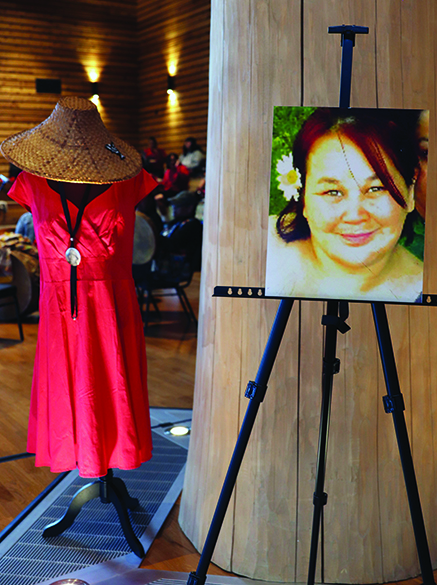
Upon stepping into the entryway of the Gathering Hall, attendees were handed red t-shirts and the Tulalip Youth Council were also passing out candles for the candlelight vigil. Directly behind them was a large poster, where the youth invited the people to write down the names of their loved ones or a message to the victims of the MMIWP epidemic.
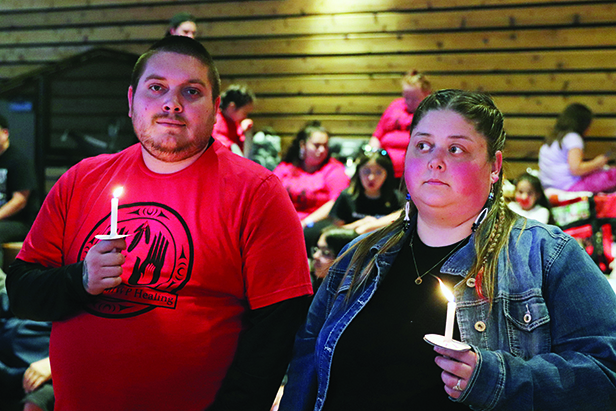
Twelve Tulalip tribal members, who are missing or were murdered, were recognized during the Friday night gathering. Their selfies and family photos were highlighted in a slideshow, that was casted on several large projector screens, and it continuously played on a loop throughout the entire evening. Their portraits were also featured beside red dresses, a national symbol that helps bring attention to the MMIWP crisis, all throughout the Gathering Hall. And keeping true to Tulalip’s MMIWP slogan, we’re going to pay our respect and say their names here as well; Cecil Lacy Jr., Anthony Kitsap Sam, Bridgette Simpson, Mary Davis Johnson, Nina Mae Dell, Kyle Van Jones-Tran, Sophia Solomon, Hayleigh Jo McGhie, Jessica Christian Jones, Andrew M.L. Fryberg, Gina Blatchford, and Jolene Leanne Flores.
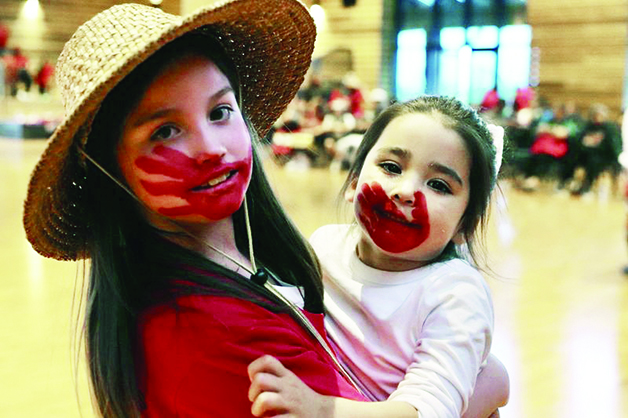
While the people settled in and shared a meal together, members of the Tulalip Board of Directors offered a few words to kick-off the event.
Said Theresa Sheldon, “I’m so grateful that we can come together and actually be honest and open and talk about what MMIWP means to us. We wear them on our shirts, and we post on social media who we lost. We say their names, so they’re not forgotten. We say their names, so they know they were loved and cared about.”
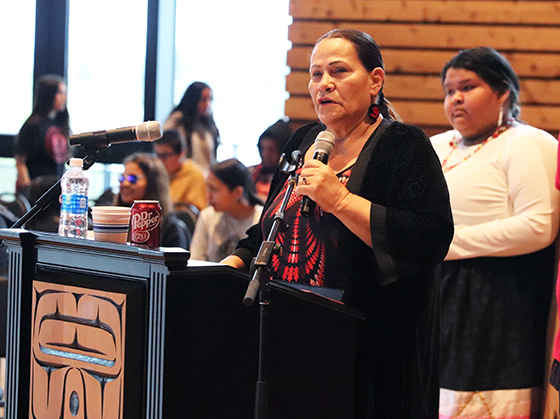
Added Chairwoman, Teri Gobin, “My heart goes out to those who are still missing, the families whose hearts are broken, and all of those families who have suffered from the loss of a loved one. I know that by having these events, by saying their names, by being here together, we honor those who are missing or were murdered. Keep a warm place in your heart for them and always remember their names. They were our members, they were our family, they were our community. We will always be here to try to do whatever we can to honor them and tell the families how much we love them; how much we appreciate them. And we’ll pray for those to come home and those who are still suffering, we just love them.”
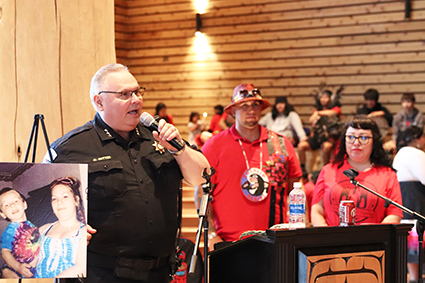
Other guest speakers that evening included the Tulalip Chief of Police, members of the Tulalip Bay Fire Department, Lena Hammons who is on the National Board for Human Trafficking and Domestic Violence, as well as the team who helped organize the event, which consisted of both government employees and community members. The Tulalip Legacy of Healing and Child Advocacy Center were in attendance, providing information about the services they offer, as was the recently established Crisis Response Team.
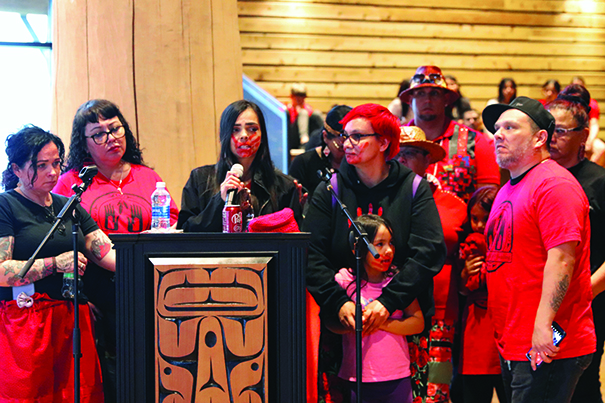
“I am here to ask all of you to start working toward prevention. Educate yourself. If you or someone you know is in a DV relationship, reach out for help,” urged Lena. “The Tribe has a lot of resources. TPD takes it very seriously. The Child Advocacy Center and the Legacy of Healing take it very seriously, you just have to reach out. We can save each other. We can protect each other. Let’s take care of each other and please, let’s love each other.”
There wasn’t a dry eye in the Gathering Hall when it came time for families to share the stories of either the disappearance or murder of their loved ones. Through heavy sobs, the mothers and fathers who spoke on the mic, pleaded for the parents in the building to tell their kids they love them on a daily basis. And they advised everyone in the hall to step-in and step-up if they notice their loved one has become involved in an abusive and unhealthy relationship. Whether looking for the whereabouts of their lost family member or seeking justice for those who were murdered, each family asked for the community’s support and help in bringing closure to the families.
Nona Davis, sister of Mary Davis Johnson, shared, “I would just like to say that we appreciate everybody who is here today. We ask that you please tell anybody and everybody about our sister, Mary Davis Johnson, who has disappeared. All we want is her to be back. I want her back. Our family wants her back. And with everything that we been through, it’s been a struggle – but tonight I can say that we’ve all been through this together, because everybody that is gathered here today is going through the same thing we’re going through. And we support everybody here, and all we want in return is the same from everybody else, the support to help us find our sister.”
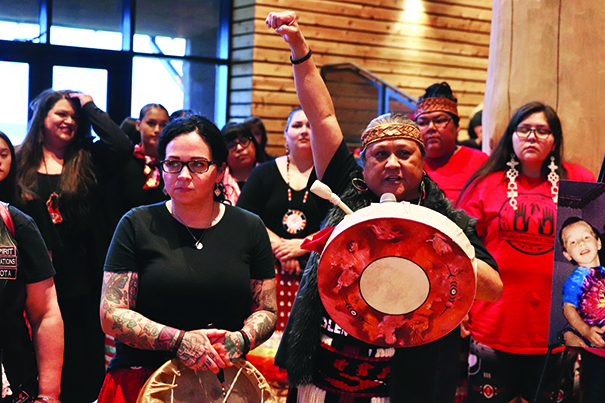
Tribal members Sarah Hart and Monie Ordonia were honored and recognized for their efforts in bringing attention to the epidemic. The week leading up to National MMIWP Awareness Day, Sarah and Monie dedicated their time to help raise awareness for the MMIWP crisis by placing red dresses and red shirts in highly visible areas throughout the reservation. As mentioned earlier, red dresses have become the national symbol to help raise awareness for the Missing and Murdered Indigenous Women and Persons epidemic. Each dress is hung upright to give the illusion that someone is wearing it, but the woman whom it belongs to is missing. Sarah and Monie painted the names of those Tribal members who fell victim to the epidemic on each article of clothing that they hung up this year.
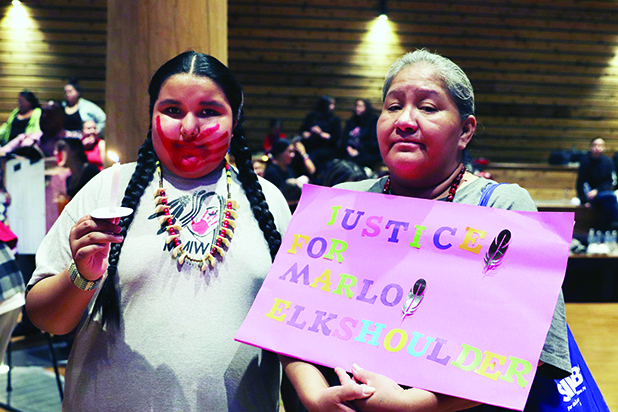
While they were in the process of conducting this work, Sarah took to Facebook and said, “In 2020, I knew I wanted to bring awareness for our communities, for our brothers and sisters. I started hanging up red dresses, and my first year I did it alone. My second year, I put the call out asking if anyone wanted to come with. Monie showed up bright and early to meet me and we have been doing this every year together since. We pray, smudge, and do this with the best intentions and love in our hearts. It’s not for the clout. It’s not about likes. It’s not about being boastful. It’s about awareness.”
Sarah and Monie then invited all the women in attendance up to the floor, and together they created a beautiful and powerful moment as they sang the Women’s Warrior song. On the last verse, they all put their fist in the air to send strength and honor those lives lost and those souls who are still missing.
Following the event, Monie shared, “Thank you all who came over to the Tulalip Gathering Hall for our MMIWP Awareness Day event. It was a very emotional evening. I pray that we were able to honor those loved ones we have lost, who are either missing or murdered. I hope in some ways we could be part of the medicine that brings healing to the survivors who are still affected by the loss of their loved ones.”

Josh Fryberg, the event’s emcee, called for a moment of silence for the victims of the epidemic and their families. He then asked the families to gather at the center of the floor so that the singers and dancers could offer their prayers and medicine byway of traditional drumbeats. Antone George (Lummi) was in attendance to lead the drummers with the impactful MMIW song, which he composed and contain the lyrics: Every day and every night, I pray, pray for you. I love and miss you. Sister, come home.
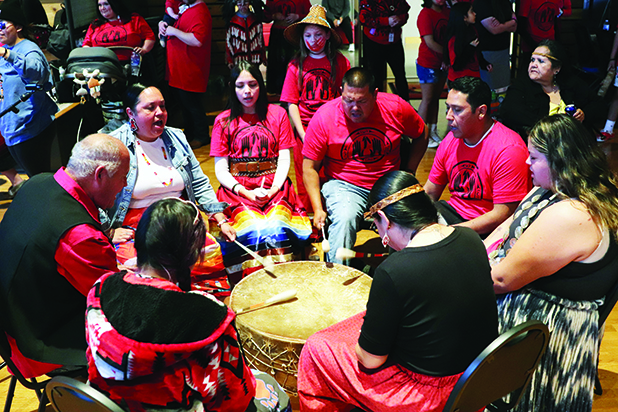
The night concluded with a coastal jam as the crowd formed a circle to witness the dancers and singers pour their hearts out on the floor, in dedication of their lost or murdered loved ones.
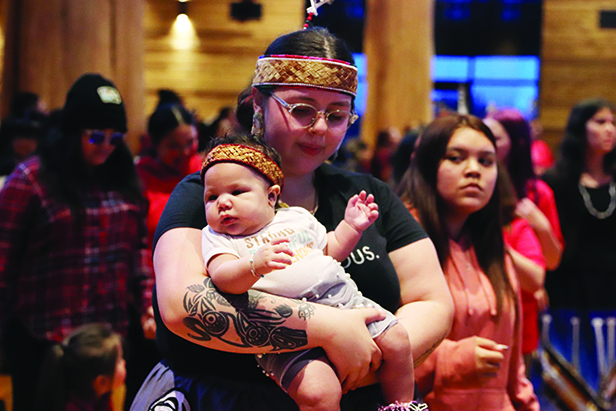
Tulalip tribal member, Cary Williams, stated, “I’m in support here today for my family, our Tribe, in solidarity of all the families affected. Personally, I am affected. One of my best friends from high school is currently missing right now. It affects all communities. These prayers are something we can do on our part to uplift those relatives who are missing, to call out to their spirit and call them home, here to us. And for the relatives who are gone, who are not with us any longer, this is a time for us to let our emotions go, on this floor. And this is the best way we can be possible – in our culture, active in our lifeways here in Tulalip. Today, it really uplifts my heart to lay it out on the floor and walk out of this place much lighter than when I walked in. And to be able to put my best friends name on that poster was healing for me that I didn’t know I needed.”
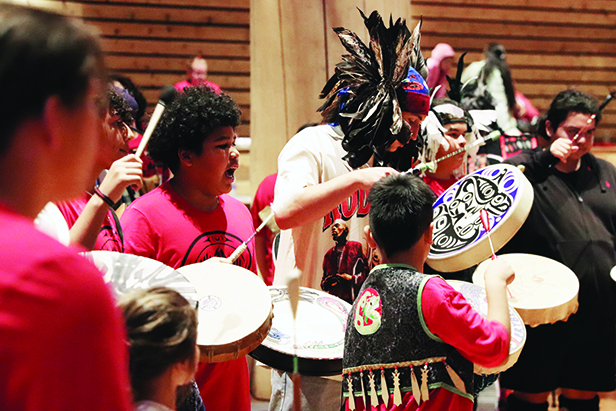
If you would like to learn more about the MMIW epidemic, please visit www.NativeHope.org for more information. And if you have any information regarding those Tribal members who are missing, please contact TPD at (360) 716-9911.
“This was healing for me, especially after what happened with my cousin Jenzele,” expressed Youth Council member, Arielle Valencia. “It just felt really nice being here and to heal in a way of decolonization. It really proves how healing our culture is and how far we have come.”
When asked what the key takeaway is for the youth she said, “Learn your culture, be able to respect others, and be on the lookout for other people. You may not know the person, but you’re related. You’re related to everyone on the rez no matter what. Blood or not. Be connected to them.”
Upcoming events & activities at Tulalip
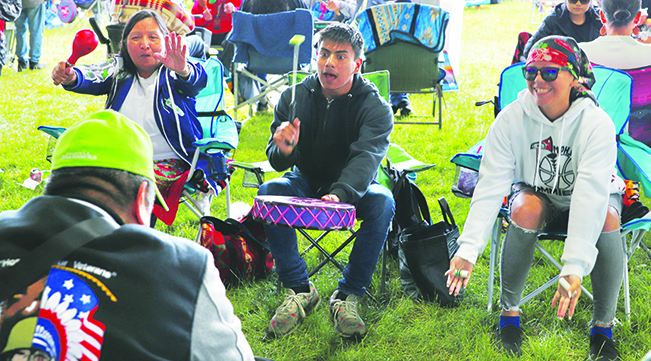
By Kalvin Valdillez, Tulalip News
Summer is right around the corner! As the weather warms up and the kiddos prepare for their last stretch of school for the year, one can’t help but look ahead at all the exciting, engaging, and educational events that are on the horizon at Tulalip.
Tulalip is known for planning an entertaining summer each year, which always includes a healthy dose of imparting cultural knowledge to the next generations. For tribal members, summertime events and activities are often based around the act of exercising your treaty rights and flexing your tribe’s sovereignty through harvesting cedar, huckleberries, and salmon, as well as selling federally legal fireworks at Boom City.
With several events scheduled to happen over the next two months, it might be easy to overlook and ultimately miss out on any number of the upcoming gatherings. For this reason, we compiled a list of some of the major happenings taking place at Tulalip throughout May and June. So, make sure to bookmark this story and input these following dates into your digital calendar!
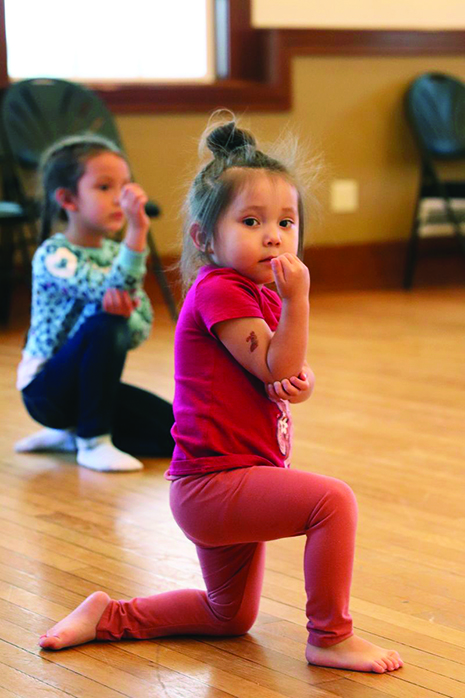
Culture Night – Every Tuesday – 5:30 p.m. at the Kenny Moses Building
Come join the community for a night of jamming and regalia crafting! This is a great gathering to help introduce the kiddos and newbies alike to the cultural way of life. Songs and dances are practiced at a slower pace, ensuring that the youngins learn every step and chant, so they will be ready to perform at game speed when the time comes.
This year, the community is focused on making color matching regalia items that include shawls and vests, so they can proudly represent Tulalip at all the upcoming cultural events taking place this summer.
Canoe Practice – Every Wednesday – 5:30 p.m. at the Tulalip Marina
Build up your endurance for this year’s pull to Puyallup for the youth canoe journey! Although the paddle to Ahousaht was canceled, the epic and fan favorite event will continue with a journey for tribal youth throughout the region.
Not participating in the canoe journey? Come on out anyway and enjoy that powerful connection to the Salish Sea, that is a unique spiritual experience for coastal tribal members. And who knows, there may be an opportunity for you to navigate the traditional waterways this summer. In years past, when the Canoe Journey was canceled during the pandemic, the Tribe organized a pull to Lopez Island for a camping trip. Similarly, the recovery community often plans a recovery camp out at Lopez, that is sure to include a canoe pull through the local waters.
Salmon Ceremony Practice – Every Thursday – 5:30 p.m. at the Tulalip Gathering Hall
Learn about the importance of the Tribe’s annual Salmon Ceremony and the story of its revival that occurred in the seventies. Salmon Ceremony practice is special to witness because this a space where Tribal leaders and elders pass down teachings to the next generation in real time. There are nearly a dozen songs and dances that the Tribe rehearses each practice, which of course is all in preparation for welcoming and honoring the first king salmon of the year.
Salmon Ceremony is set for June 1 at 10:30 a.m.
War Canoe Races – Happening this weekend (5/4 & 5/5) – All Day at Tulalip Bay
A thrilling occurrence for both competitors and spectators alike, the Salish-wide canoe racing event will make an early appearance at Tulalip Bay this year. In fact, if you are reading this fresh out your mailbox, get yourself over to the teen center campus to catch a good view of the races!
Over a hundred racers take part every year and hit the waters at full speed, making laps from the Tulalip longhouse to Hermosa beach and back again. Designed with swiftness in mind, the war canoes are sleek and narrower than traditional cedar dugouts. Racers train year-round in hopes of bringing home the first-place trophy for the Tulalip Bay circuit. This year there will be single, double, six-man, and eleven-man races throughout the weekend.
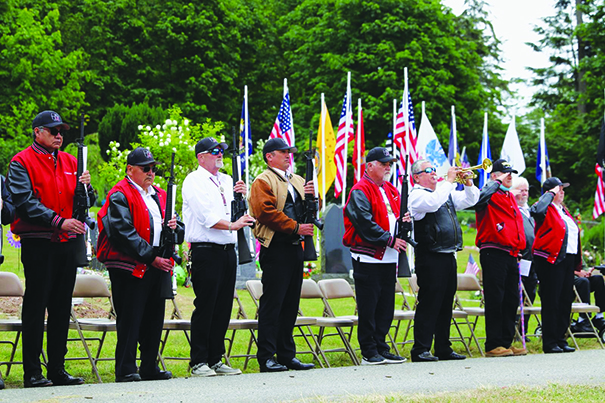
Memorial Day – 5/27 – 10 a.m. service at Priest Point Cemetery, 11 a.m. service at Mission Beach Cemetery
In observation of Memorial Day, the Tulalip Tribes holds two services every year, as many of the Tribe’s membership enlisted and proudly served in the US military. The community gathers at both the Priest Point and Mission Beach cemeteries to honor and remember those fallen soldiers who paid the ultimate sacrifice while protecting this Nation’s freedom.
The Tribe also takes time to thank the Tribal veterans, Gold Star Mothers, as well as any current active-duty members of the military for their service. At the end of each ceremony, the Tribe pays tribute to the fallen soldiers with a 21-Gun Salute by the Tulalip Honor Guard, as the names of those who served and are no longer with us are read aloud during roll call.
Tulalip’s Annual Stick Games Tournament – Weekend of May 31 – all day at the Tulalip Amphitheater
The Tulalip Amphitheater has become the official home for the Tribes annual stick games tournament. Natives from all across North America journey to the Tulalip rez to try their luck at the traditional game that has been practiced amongst Northwest tribes and First Nation bands for thousands of years. Numerous teams participate every year at Tulalip and play for a chance to win cash prizes.
This year’s total payout is $50,000 and the grand prize is $25,000. There will also dozens of vendors at the tournament selling the likes of Indian tacos, snow cones, smoked salmon, kettle corn, as well as Native-designed clothing, blankets, and jewelry.
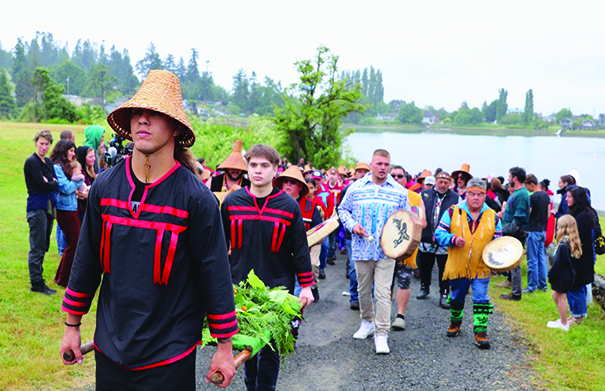
Salmon Ceremony – June 1 – 10:30 a.m. at the Tulalip Longhouse
Once a year, during the first weekend of June, Tulalip members gather at the Tribe’s longhouse to honor and pay tribute to big chief yubəč, the king salmon. For generations, the salmon have provided delicious nourishment for the people. And to show their respect, Tulalip holds an annual Salmon Ceremony celebration at the start of each fishing season to welcome the first king salmon of the year.
Celebrated since the beginning of time, the traditional ceremony was once outlawed during the assimilation era. In the mid-70’s, the ceremony was revived by Harriette Shelton Dover and a number of Tulalip elders. The gathering also serves as a way to bless the local fisherman as they prepare for a season on the water.
Powerful songs, stories and dances are shared as the first salmon of the season is escorted onto the shore of Tulalip Bay. After the people offer a blessing, through song, prayer, and dance, the salmon is prepared, served, and enjoyed by the entire community together. The remains are sent back to the Salish Sea, so that yubəč can return to his village and tell the salmon people how well he was treated by the community of Tulalip. And in turn, the salmon will continue to run through the waterways of Tulalip Bay and serve as sustenance for the Tribe throughout the summer.

Boom City – Mid-June – July 4th at Boom City site
The Northwest pyrotechnic capital will officially be open for a two-week period this June! Tulalip entrepreneurs will set up their vibrant and creatively designed stands at the lot located behind the Tulalip Resort Casino approximately around the weekend of June 21.
As always, the stand owners will have innumerable types of fireworks available for purchase including cakes, firecrackers, bottle rockets, sparklers, Roman candles, fountains, smoke bombs, pop-its, and many more. Boom City also offers a designated area for people to enjoy their fireworks safely and legally. Several food vendors will be stationed at Boom City as well, serving up treats such as Hawaiian shaved ice, frybread and tacos.
Fatherhood Café coming to Tulalip May 22

By Kalvin Valdillez, Tulalip News
Help spread the word! A four-hour event, dedicated to empowering Tulalip fathers, and other tribal dads, will be held at the TELA gym on Wednesday May 22. Known as the Fatherhood Community Café, the event is organized by the Washington Fatherhood Council and has been held in various counties in our state over the past few years.
Tulalip will be one of the few, if not the first, Washington State tribe the council has collaborated with. The departments that are involved in planning the event, which is officially dubbed ‘Dad Allies Community Café’ for the Tulalip stop, include Family Haven, TELA, and Housing. In addition to the abundance of resources and information that will be available at the community café, the departments incorporated time for some culture and is inviting fathers to bring their drums for a mini coastal jam.
According to research by the National Fatherhood Initiative, 1 in 5 children live without a father in the home unit within Washington State. The same study showed that 30% of single parents in our state are dads.
Said Dieter Jacobs, Child Support Program Administrator at Washington State Department of Social and Health Services, “Research shows that when fathers are engaged, the children do better, and we need to support that. Dads bring something different to the table in that fatherhood role. We need to support fathers – we need to support the whole family. With the café, we want to get providers at the table to chat with the dads. We want them to talk about local happenings as well as things like child support, court, access to education, and for those incarcerated– how to support them while they’re in jail and how do we continue that when they come out. But it’s important we get them talking about what’s working, what’s not working, and what would work. Just sharing info and giving them an opportunity to ask questions. And dad allies are invited too – in laws, girlfriends.”
Dieter, who is also a member of the Washington Fatherhood Council, explained that the council is advocating for local fathers statewide by raising awareness, assisting in policy changes to be more inclusive for dads in state programs and schools, and also through a number of activities that include an annual fatherhood summit, a workshop series, and the fatherhood cafés.
Space is limited, so if you are interested in attending the Dad Allies Community Café, please sign-up at https://www.eventbrite.com/e/fathers-matter-a-community-conversation-with-tulalip-tribal-dads-tickets-850985940857. The event begins at 10 a.m. and runs until 2 p.m. Fathers who choose to participate in the café will receive a gift card incentive for their time. Childcare will also be offered during the day of the event, so dads can take their time and learn about a number of topics such as housing, employment, and fatherhood services.
A free lunch will be catered by local Hawaiian restaurant, Taste of Aloha. And there will plenty of chances to win an assortment of prizes by participating in a basketball shooting contest, a cornhole contest, and a raffle.
“We want to make sure our fathers have support and can come together and build a core group, build community, and have space to move forward in a good way,” expressed Sasha Smith, Family Haven’s Youth and Family Support Coordinator. “We want to help give them tools to feel more successful and to engage in services, culture, community, and help them be the dad that they want to be. We hear you, Indigenous dads. We’re here for you, we want to support you. Make sure you sign up and come break bread with us.”
